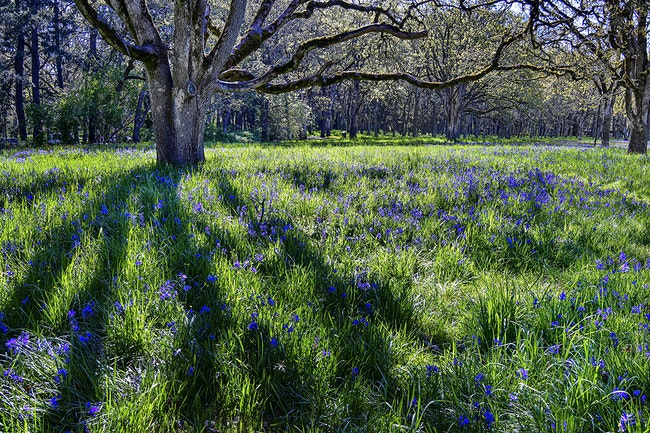
An oak tree casts a long, early morning shadow across a field of camas root in bloom at Bush’s Pasture Park in Salem. (Ron Cooper/Salem Reporter)
Salem wants the community’s help to plan for the future of one of its premier parks.
A city survey is seeking feedback on a management plan for Bush’s Pasture Park and the Deepwood Estate Gardens until Dec. 22.
SURVEY LINK: Cultural Landscape Management Plan
A new Cultural Landscape Management Plan, which should be complete by spring 2021, aims to maintain the character of the beloved park and estate and protect sensitive ecosystems, like Oregon white oak stands.
The Mission Street Parks Conservancy commissioned a study in 2018 on the white oaks and found that soil compaction from walkers and vehicles was the biggest threat to some of the trees.
It recommended policies to restrict traffic in the more sensitive areas of the park and to plant in the understory of the tree canopy to increase diversity.
The plan will guide management of the area for the next few decades. When it’s complete it will go before the Salem City Council for review next year.
Bush’s Pasture Park takes up about 90 acres in central Salem and was once the estate of Oregon settler and entrepreneur Asahel Bush II, who bought the property at what was then the city’s southern outskirts in 1860. The Bush family donated a portion of the property to Salem in the early 1900s following Bush’s death.
In August, 232 people completed a city survey asking why they use the park, its best features and the park’s biggest challenges.
Most respondents said walking was their favorite activity at Bush’s Pasture.
More than half of respondents said maintaining the health of oak, camas and other plant species was the biggest challenge facing the park.
Some of the planned projects in the park include protecting the Oregon white oak stand and Pringle Creek, and maintaining or expanding camas protection in areas linked to the Kalapuya Indians.
The conservancy report notes the oak woodlands represent a rare and cherished link to the past.
“Although these lands have been managed for centuries, first by Native American tribes and more recently by agriculturalists and municipal park managers, a direct line exists from the Oregon white oak ecosystem which has thrived here for millennia and the state of the park today. The trees in this park are in an environment they are well suited to, and the trees at this site likely derive from the exact provenance where they grow today. This sort of continuity is incredibly rare in the center of an urban space and adds to the value of this already invaluable resource,” the report reads.
Related coverage: Salem historic parks get a fresh look and plans for future work
Have a tip? Contact reporter Saphara Harrell at 503-549-6250, [email protected].
OUR HOLIDAY SPECIAL: Save 25% and support careful, in-depth reporting on your community. https://www.salemreporter.com/subscribe









